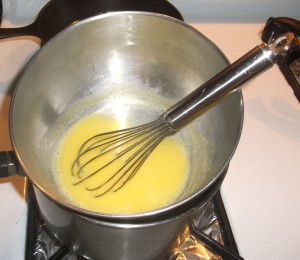Five Mother Sauces
Many years ago, mostly as a result of the French Revolution and the subsequent reduction of the great houses of France and their kitchens with essentially unlimited resources and help, professional cooks began the process of simplifying their work. One of the major contributions of this period, documented by Antonin Carême, and later expanded upon by Auguste Escoffier, was the development of the categories of master sauces. These master sauces were intended to be the basis of all other sauces, needing only the addition of a few ingredients to customize them to a particular dish.
Sauces provide flavor in liquid form and with a pleasing consistency. They are used to enhance the flavors of the dish. Through sauces the cook has a broad range of flavors at hand. Although sauces can be made of fruit, soy, grains, fish, and also include gravies, the earliest European sauces focused primarily on meat reductions. Sauces that were thickened with flour were much more economical than those thickened with meat reductions so became much more popular during that time period.
Previously, we at Lukewarm Legumes started our Saucier series of blogs. This will serve as an introduction to that series by providing part of the history of sauces.
The earliest categories of sauces in Europe were these four:
Espagnole (brown sauce): made with brown meat stock (beef or veal), brown roux, and tomatoes.
Velouté (velvety): made with white stock (fish or chicken) and yellow roux.
Béchamel: made with milk and white roux
Hollandaise: made with butter, eggs, and lemon juice
Later Tomato Sauce would be included in the list.
Today we will focus on Hollandaise Sauce.
Everybody knows that oil and water do not mix; except, when blended in the presence of an emulsifier. The yolk of the egg is itself an emulsion of oil and water with the capability of emulsifying a vast amount of additional liquid. In speaking of another emulsion sauce, mayonnaise, Harold McGee says, “Though cookbooks often say that the ratio of oil to egg yolk is critical, that one egg yolk can only emulsify a half-cup of oil, this just isn’t true. A single yolk can emulsify a dozen cups of oil or more…” (On Food and Cooking, p.634).
Hollandaise Sauce is perhaps one of the most feared sauces to make because of the possibility of curdling the eggs. The important thing to remember is to first blend the egg yolks with the lemon juice. Adding the lemon juice and its acidity helps prevent curdling of the eggs. Using a double boiler will provide a gentle and even heat. The trick is to fully incorporate small slices or butter fully into the egg yolks before adding more and to heat the egg yolks enough to produce the desired thickness, but not so much as to cause the yolk proteins to curdle into solid form.
Here is a basic Hollandaise Sauce recipe:
HOLLANDAISE SAUCE
Ingredients
2 egg yolks
1 t Lemon juice
2 t Water
8 T Butter (one stick), cut into small pieces
1/2 teaspoon kosher salt
1/8 teaspoon cayenne pepper
Instructions
In the top part of a double boiler over medium heat, whisk egg yolks, lemon juice and water until warm enough to melt the butter.
Add butter slices one at a time, whisking until fully incorporated.
After all butter has been added, whisk in salt and cayenne pepper.
Now that you know how quick and easy it is to make this delicious sauce, why not serve it warm over a fried (or poached) egg and ham on an lightly toasted English Muffin for breakfast tomorrow?

